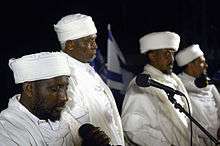Kahen
Kahen (Ge'ez: ካሀን kahən "priest", plural ካሀንት kahənat)[1] is a religious role in Beta Israel second only to the monk or falasyan.[2] Their duty is to maintain and preserve the Haymanot among the people. This has become more difficult by the people's encounter with the modernity of Israel, where most of the Ethiopian Jewish people now live.[3]
| Part of a series of articles on |
| Priesthood in Judaism |
|---|
| |
|
Kohen · Recognition of priestly descent Priestly covenant |
|
High Priests Aaron · Eleazar · Phinehas · Eli · Ahimelech · Abiathar (First Temple) · Zadok · Shallum · Hilkiah · Jehoiada (Second Temple) Joshua the High Priest Simeon the Just Yishmael Ben Elisha Yehoshua ben Gamla Pinchus Ben Shmuel |
|
Twenty-four kohanic gifts The ten gifts given in the Temple 1. Sin offering · 2. Guilt offering 3. Communal peace offering 4. Fowl sin offering · 5. Leftovers from the suspensive guilt offering 6. Oil from the offering for the leper 7. Bread from First Fruits · 8. Showbread 9. Leftovers of the meal offering 10. Leftovers of the First Sheaf.
15. Heave offering 16. Heave offering of the Levite's tithe 17. Dough offering 18. First shearing of the sheep 19. Shoulder, cheeks and maw 20. Coins for redemption of the first born son · 21. Redemption of a donkey · 22. Dedication of property to a priest · 23. Field not redeemed in a Jubilee year · 24. The property of the foreigner with no heir. |
|
Priestly Garments |
|
Miscellaneous topics The Mitzvah of sanctifying the Kohen Kohanic disqualifications Holy anointing oil Kahen Aaron's rod Bat-Kohen (daughter of a kohen) Sons of Zadok Contact by a kohen with a dead body 13 Kohanic cities |
The high priest (ሊቀ ካሀንት liqa kahən, plural ሊቃነ ካህናት liqanä kahhənat) is the leader of the priests in a certain area.
An aspiring kahen must spend time studying as a debtera before being ordained. As a debtera, he will be closer to the laypeople and serve as an intermediary between them and the clergy. Upon becoming a kahen, he will no longer perform the services of a debtera, though he may take them up again if he gives up his position or is deposed.[4]
The term qäsis (Ge'ez: ቀሲሰ, Amharic: ቀሰ qəs; Tigrinya: ቀሺ qäši),[5] which refers to married priest in the Ethiopian and Eritrean Orthodox Tewahedo Churches, is a synonym for kahen, an unmarried priest, among the Beta Israel.[6][4] With the aliyah of Beta Israel to Israel, the Amharic "qəs" Hebraized was translated as Kes (Hebrew: קס or קייס, plural קסים or קייסים Kesim).
Notable priests
- Liqa Kahenat Berhan Baruch (1910–1984) – main leader of the Beta Israel from the Italian occupation until his death.
- Liqa Kahenat Isaac Yaso (1892–1997) – main leader of the Jews in Tigray.
- Liqa Kahenat Raphael Hadane (born August 12, 1923) – religious leader of the Jews in Ambover.
- Kes Avihu Azariya – head of the council of Ethiopian High Priests.
See also
References
| Wikimedia Commons has media related to Kahenat (Beta Israel). |
- Leslau, Wolf (1987). Comparative dictionary of Geʻez (Classical Ethiopic) : Geʻez-English, English-Geʻez, with an index of the Semitic roots ([Nachdr.]. ed.). Wiesbaden: O. Harrassowitz. p. 278. ISBN 978-3-447-02592-8.
- Dillmann, August (1865). Lexicon Linguae Æthiopicae. Leipzig: Weigel. p. 1342.
- Shai Afsai, "Past in the Present: An inside look at Sigd — the holiday of Ethiopian Jewry — and the struggle to secure its survival", AMI Magazine, December 5, 2012, pp. 78–85.
- Isaac Greenfield, "The Debtera and the education among Ethiopian Jewry until the arrival of Dr. Faitlovitch" in Menachem Waldman (ed.), Studies in the History of Ethiopian Jews, Habermann Institute for Literary Research, 2011, pp. 109–135 (Hebrew).
- plural, Ge'ez: qesawast, Tigrinya: qesawasti, Amharic: qesoch
- Emmanuel Fritsch, "Qäsis" in Siegbert Uhlig (ed.), Encyclopaedia Aethiopica: O-X, Harrassowitz, 2010, ISBN 3447062460, pp. 262-264.
